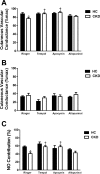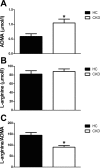NADPH oxidase-derived reactive oxygen species contribute to impaired cutaneous microvascular function in chronic kidney disease
- PMID: 24761000
- PMCID: PMC4059972
- DOI: 10.1152/ajprenal.00058.2014
NADPH oxidase-derived reactive oxygen species contribute to impaired cutaneous microvascular function in chronic kidney disease
Abstract
Oxidative stress promotes vascular dysfunction in chronic kidney disease (CKD). We utilized the cutaneous circulation to test the hypothesis that reactive oxygen species derived from NADPH oxidase and xanthine oxidase impair nitric oxide (NO)-dependent cutaneous vasodilation in CKD. Twenty subjects, 10 stage 3 and 4 patients with CKD (61 ± 4 yr; 5 men/5 women; eGFR: 39 ± 4 ml·min(-1)·1.73 m(-2)) and 10 healthy controls (55 ± 2 yr; 4 men/6 women; eGFR: >60 ml·min(-1)·1.73 m(-2)) were instrumented with 4 intradermal microdialysis fibers for the delivery of 1) Ringer solution (Control), 2) 10 μM tempol (scavenge superoxide), 3) 100 μM apocynin (NAD(P)H oxidase inhibition), and 4) 10 μM allopurinol (xanthine oxidase inhibition). Skin blood flow was measured via laser-Doppler flowmetry during standardized local heating (42°C). N(g)-nitro-l-arginine methyl ester (L-NAME; 10 mM) was infused to quantify the NO-dependent portion of the response. Cutaneous vascular conductance (CVC) was calculated as a percentage of the maximum CVC achieved during sodium nitroprusside infusion at 43°C. Cutaneous vasodilation was attenuated in patients with CKD (77 ± 3 vs. 88 ± 3%, P = 0.01), but augmented with tempol and apocynin (tempol: 88 ± 2 (P = 0.03), apocynin: 91 ± 2% (P = 0.001). The NO-dependent portion of the response was reduced in patients with CKD (41 ± 4 vs. 58 ± 2%, P = 0.04), but improved with tempol and apocynin (tempol: 58 ± 3 (P = 0.03), apocynin: 58 ± 4% (P = 0.03). Inhibition of xanthine oxidase did not alter cutaneous vasodilation in either group (P > 0.05). These data suggest that NAD(P)H oxidase is a source of reactive oxygen species and contributes to microvascular dysfunction in patients with CKD.
Keywords: cutaneous vasodilation; kidney disease; nitric oxide; oxidative stress.
Copyright © 2014 the American Physiological Society.
Figures




Similar articles
-
Modulation of cutaneous vasodilation by reactive oxygen species during local and whole body heating in young and older adults.Am J Physiol Regul Integr Comp Physiol. 2024 Dec 1;327(6):R543-R552. doi: 10.1152/ajpregu.00127.2024. Epub 2024 Sep 6. Am J Physiol Regul Integr Comp Physiol. 2024. PMID: 39241006
-
Reactive oxygen species (ROS) from NADPH and xanthine oxidase modulate the cutaneous local heating response in healthy humans.J Appl Physiol (1985). 2011 Jul;111(1):20-6. doi: 10.1152/japplphysiol.01448.2010. Epub 2011 Mar 24. J Appl Physiol (1985). 2011. PMID: 21436462 Free PMC article.
-
Role of mitochondria-derived reactive oxygen species in microvascular dysfunction in chronic kidney disease.Am J Physiol Renal Physiol. 2018 Mar 1;314(3):F423-F429. doi: 10.1152/ajprenal.00321.2017. Epub 2017 Nov 8. Am J Physiol Renal Physiol. 2018. PMID: 29117995 Free PMC article.
-
Edward F. Adolph Distinguished Lecture: Skin-deep insights into vascular aging.J Appl Physiol (1985). 2017 Nov 1;123(5):1024-1038. doi: 10.1152/japplphysiol.00589.2017. Epub 2017 Jul 20. J Appl Physiol (1985). 2017. PMID: 28729391 Free PMC article. Review.
-
Chronic Kidney Disease and Disproportionally Increased Cardiovascular Damage: Does Oxidative Stress Explain the Burden?Oxid Med Cell Longev. 2017;2017:9036450. doi: 10.1155/2017/9036450. Epub 2017 Nov 23. Oxid Med Cell Longev. 2017. PMID: 29333213 Free PMC article. Review.
Cited by
-
Hemodynamic and neuromuscular basis of reduced exercise capacity in patients with end-stage renal disease.Eur J Appl Physiol. 2024 Jul;124(7):1991-2004. doi: 10.1007/s00421-024-05427-0. Epub 2024 Feb 19. Eur J Appl Physiol. 2024. PMID: 38374473
-
Oxidative Stress Contributes to Microvascular Endothelial Dysfunction in Men and Women With Major Depressive Disorder.Circ Res. 2019 Feb 15;124(4):564-574. doi: 10.1161/CIRCRESAHA.118.313764. Circ Res. 2019. PMID: 30582458 Free PMC article.
-
The effect of exercise on vascular health in chronic kidney disease: a systematic review and meta-analysis of randomized controlled trials.Am J Physiol Renal Physiol. 2023 Nov 1;325(5):F638-F655. doi: 10.1152/ajprenal.00152.2023. Epub 2023 Sep 21. Am J Physiol Renal Physiol. 2023. PMID: 37733834 Free PMC article.
-
Regulation of exercise blood flow: Role of free radicals.Free Radic Biol Med. 2016 Sep;98:90-102. doi: 10.1016/j.freeradbiomed.2016.01.017. Epub 2016 Feb 10. Free Radic Biol Med. 2016. PMID: 26876648 Free PMC article. Review.
-
Exercise intolerance in kidney diseases: physiological contributors and therapeutic strategies.Am J Physiol Renal Physiol. 2021 Feb 1;320(2):F161-F173. doi: 10.1152/ajprenal.00437.2020. Epub 2020 Dec 7. Am J Physiol Renal Physiol. 2021. PMID: 33283641 Free PMC article. Review.
References
-
- Abularrage CJ, Sidawy AN, Aidinian G, Singh N, Weiswasser JM, Arora S. Evaluation of the microcirculation in vascular disease. J Vasc Surg 42: 574–581, 2005 - PubMed
-
- Annuk M, Lind L, Linde T, Fellstrom B. Impaired endothelium-dependent vasodilation in renal failure in humans. Nephrol Dial Transplant 16: 302–306, 2001 - PubMed
-
- Baigent C, Burbury K, Wheeler D. Premature cardiovascular disease in chronic renal failure. Lancet 356: 147–152, 2000 - PubMed
-
- Boaz M, Smetana S, Weinstein T, Matas Z, Gafter U, Iaina A, Knecht A, Weissgarten Y, Brunner D, Fainaru M, Green MS. Secondary prevention with antioxidants of cardiovascular disease in endstage renal disease (SPACE): randomised placebo-controlled trial. Lancet 356: 1213–1218, 2007 - PubMed
Publication types
MeSH terms
Substances
Grants and funding
LinkOut - more resources
Full Text Sources
Other Literature Sources
Medical
Research Materials
Miscellaneous

